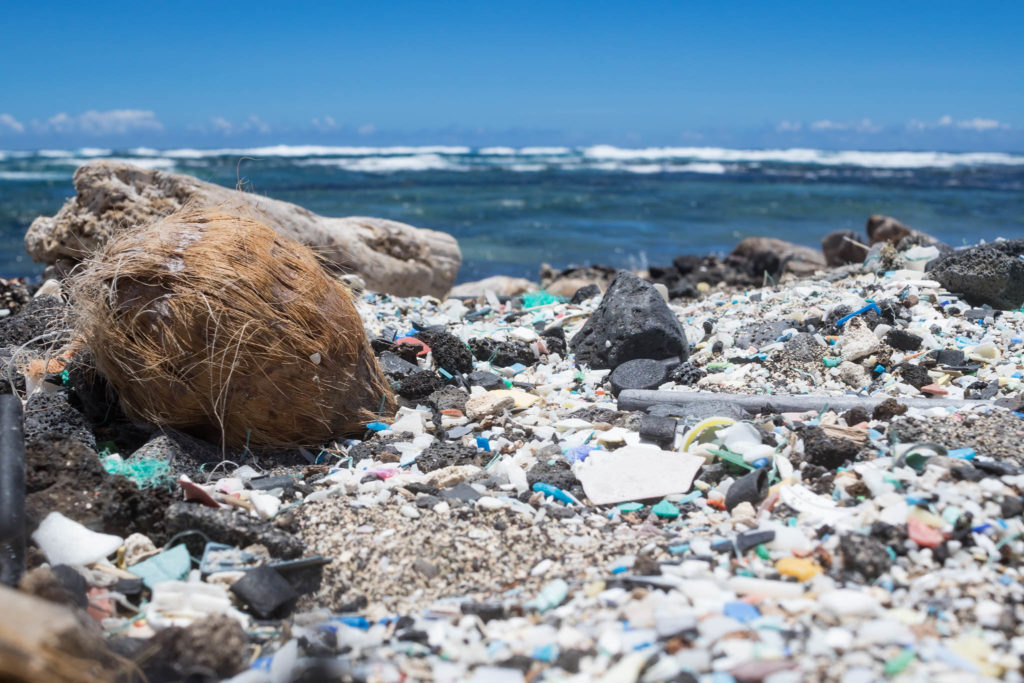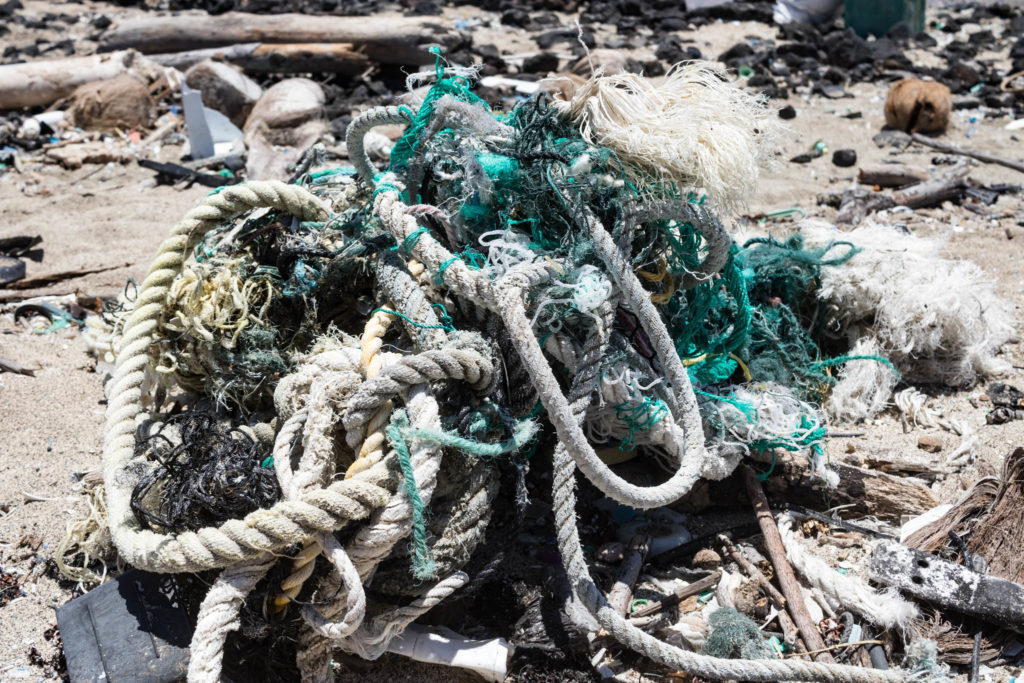Hawai‘i Shows Up in Full Force for International Marine Debris Gathering
The Hawai‘i Wildlife Fund reports that record amounts of net masses have hit Hawai‘i’s shores this year and many of the community groups who responded to their removal also attended a recent international event on marine pollution in California.
Last month, from Thursday, March 28 to Monday, March 16, 28 delegates from Hawai‘i representing numerous organizations and agencies, made their way to San Diego to attend and present at the 6th International Marine Debris Conference (“6IMDC”). This week-long event that was hosted by the National Oceanic and Atmospheric Association (NOAA) and the United Nations Environment Programme brought together more than 700 participants, from over 50 countries around the world.

Hawai’i delegates at the 6th International Marine Debris Conference in San Diego plus Captain Charlie Moore (honorary guest). Missing from this photo: Miguel Castrence (Resource Mapping Hawaii), Jens Currie (PWF), Dr. Jan Hafner (IPRC), Dr. Jennifer Lynch (NIST), Dr. Nikolai Maximenko (IPRC), and Stephanie Stack (Pacific Whale Foundation). Photo with permission from N. McKinney / Kōkua Hawai‘i Foundation.
“Hawaiʻi’s significant representation at the 6IMDC indicates not only how large an issue plastic pollution is for our islands, but it also shows the dedication of our local organizations, government agencies, researchers, and advocates to address this issue from all angles,” said Plastic Free Hawai‘i Manager Doorae Shin or the Kōkua Hawai‘i Foundation.
Over 400 oral presentations and 170 posters were shared during five days with this global community, focusing primarily on research, removal and prevention of marine debris within 10 specific tracks:
- Monitoring & Citizen Science
- Research & Microplastic/Microfibers
- Prevention
- Private Sector Collaboration, Technology, & Innovation
- Education & Communication
- Implementing Effective Law Regulations, & Policy
- Removal
- Single-Use Product Policies, Regulations, & Laws
- Derelict Fishing Gear
- Innovative Case Studies from Around the World
What is marine debris?
Marine debris or marine litter is defined as any persistent, manufactured or processed solid material discarded, disposed of, or abandoned in the marine and coastal environment. It is a global problem, and it is an everyday problem. There is no part of the world left untouched by debris and its impacts. Marine debris is a threat to our environment, navigation safety, the economy, and human health. Most of all, marine debris is preventable. (information available from: http://internationalmarinedebrisconference.org/)
“Due to its location in the Gyre, Hawai‘i remains at the frontlines of plastic invasion. With the whole world watching, we need to lead by example and take a source reduction approach mixed with an aggressive cleanup campaign that keeps our beaches clean while inspiring better consumer behaviors,” said Sustainable Coastlines Hawai‘i Executive Director Kahi Pacarro.
Hawai‘i attendees represented 4% of the total participation in this international event and demonstrated teamwork and comradery towards this common plastic pollution problem to our national and international partners. Hawai‘i has long been the leader in the marine debris community, hosting four of the sixth international marine debris conferences in Honolulu since 1984, and becoming the first state in the USA to develop an official “Marine Debris Action Plan” in 2010 (https://marinedebris.noaa.gov/report/hawaii-marine-debris-action-plan).
In March 2011, the Fifth International Marine Debris Conference (hosted by NOAA, United Nations Environment Programme and other partners) in Honolulu, Hawai‘i and had over 450 participants who came together to create the “Honolulu Strategy”, a framework document that supports the “global effort to reduce the ecological, human health, and economic impacts of marine debris.”
“We were truly honored and humbled to again be sharing our story at this international gathering,” said Hawai‘i Wildlife Fund President and Program Director Megan Lamson. “The heightened awareness of marine debris and plastic pollution over the past seven years since the last international conference is commendable, and is reflected in the 1.5x increase in attendance. The new research presented on microplastics and microfibers in our atmosphere and waterways was overwhelming, but in the end we left with a sense of urgency and inspiration to move forward, together, to solve this global epidemic for our native wildlife.”
“Plastic pollution is a global problem that potentially threatens all life on our planet. We need to approach solution with a collective mindset,” said Marine Debris Artist Shannon McCarthy. “Humans need to once again live symbiotically with the environment, not next to it or against it. With creativity, innovation, communication, and a dismantling and redesign of the current patterns of consumption, we still have a chance to write a better story of the future than the bleak outcome building plastic pollution in our oceans will inevitably provide. The Hawaiian delegation demonstrated a united front, which will be imperative to finding and enacting sustainable solutions.”
“Although the Hawaiian Islands are small and remote, their location in the North Pacific Subtropical Gyre results in high amounts of marine debris found on beaches and in surrounding waters. Marine debris travels significant distance from the edges of the Pacific Rim before reaching the coastlines of Hawai‘i,” said Research Fellow Sarah-Jeanne Royer, PhD., of the International Pacific Research Center. “Thankfully, numerous organizations on the Hawaiian Islands bring people together to clean beaches and reefs; however, their mission can only succeed if combined with prevention based on outreach education, laws, and best business practices. Ultimately, fundamental research on the dynamics and impacts of marine debris is necessary to ensure that measures are adequate and efficient. The 28 person Hawaiian contingent that participated in the 6th IMDC were from non-governmental organizations, governmental agencies, private businesses, industries and academic partners and all together we have the single objective of making a difference and reducing plastic pollution.”
Hawai‘i agencies / organizations represented at 6IMDC included:
808 Cleanups
B.E.A.C.H.
Hawai‘i Wildlife Fund
Hawai‘i Division of Aquatic Resources – Department of Land and Natural Resources
Hawai‘i Pacific University
International Pacific Research Center
Johnson ‘Ohana Charitable Foundation
Kōkua Hawai‘ Foundation
Maui Times
Nā Kama Kai
NIST National Institute of Standards and Technology
NOAA Marine Debris Program
NOAA Pacific Island Fisheries Science Center
Pacific Whale Foundation
Resource Mapping Hawai‘i
School of Ocean and Earth Science & Technology – University of Hawai‘i Mānoa
Shannon McCarthy Art
Sharkastics
Surfrider Foundation – Kaua‘i, Maui and O‘ahu Chapters
Sustainable Coastlines Hawai‘i
Swell Consulting
Contributors to this story include:
- Megan Lamson <[email protected]>
- Kahi Pacarro <[email protected]>
- Shannon McCarthy <[email protected]>
- Natalie McKinney <[email protected]>
- Sara-Jeanne Royer <[email protected]>
- Doorae Shin <[email protected]>



















